Golconda Fort – 500 Years Old Historic Structure
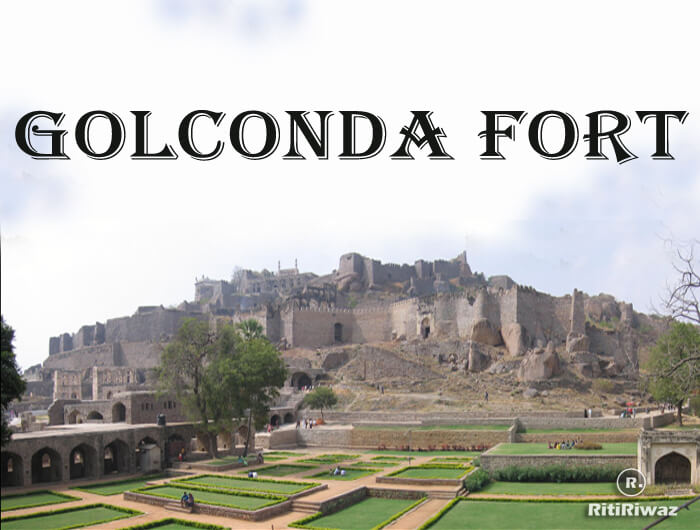
Golconda Fort also known as Gol Konda, Golla Konda, or Shepherds Hill in Telugu is a fort in Hyderabad, Telangana state in India. Golconda was the capital of the medieval sultanate of the Qutb Shahi Empire (c. 1518–1687). It is situated 11 kilometers west of Hyderabad and epitomizes the sumptuous “Nawabi” culture of the time.
The region has produced some of the world’s most famous diamonds, including the colorless Koh-i-Noor (now owned by the United Kingdom), Blue Hope (United States), pink Daria-i-Noor (Iran), and white Huh. Regent (France), Dresden Green (Germany), and the colorless Orlov (Russia), Nizam and Jacob (India), as well as the now lost diamonds Florentine Yellow, Akbar Shah, and the Great Mogul.
History
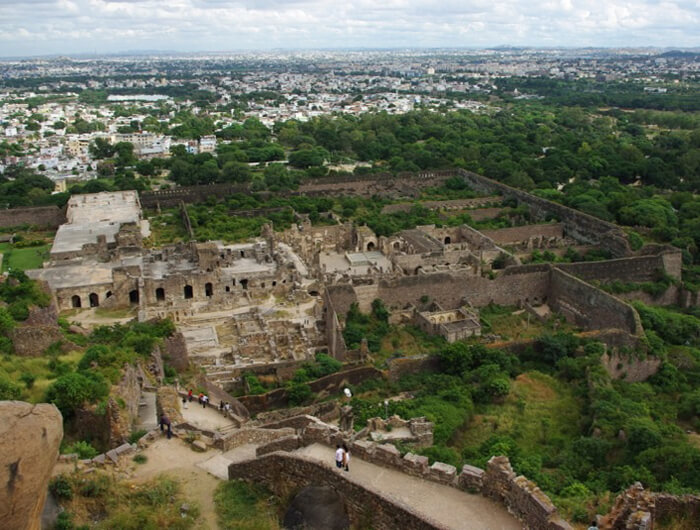
The Golconda region (Mankal) was ruled by the Kakatiyas from 1083 to 1323. The fort was built on a hill that was once the territory of the Kakatiya king of Warangal in 1143 AD. During the reign of King Pratap Rudra Deva, a shepherd suggested him to build a fort on this hill. The king welcomed the idea and built a mud fort on a granite hill. This is the reason why the fort could not withstand the invasion.
In 1336 the Musunuri leaders defeated the army of Muhammad bin Tughlaq and captured the Golconda. Musunuri Kapaya, who ruled the Golconda in 1364, ceded the region to the Bahmani Sultan Muhammad Shah as part of the Treaty of Bhupathi. From then until 1512 it became the capital of the Bahmani kingdom, after which it became the capital of the Muslim kings Qutb Shahis.
These five rulers became independent as a result of the instability of the state:
Khasim led the Shaka royal dynasty to Bidar (1492 to 1609 AD).
Fatahullah-Imadul Mulk the Imad Shahi dynasty in Berabar (1490 to 1527 BC)
Ahmad Nizamul Nizam Shahi dynasty in Ahmednagar (1490 to 1663 A.D.)
Yusuf Adil Shah (1490 to 1686) in Bijapur to the Adil Shahi dynasty
Sultan Quil (1518 to 1687) at Golconda to the Qutb Shahi dynasty
Qutb Shahi dynasty Golconda The fort was built over a period of over 60 years and was fortified on a 120-meter-high black stone hill. The fort has a perimeter of about 5 km along with towers. Golconda Fort was famous for its diamond trade during the time of the Nawabs. The world-famous Kohinoor, Orloff, Hope, and Pitt diamonds came from the Paritala-Kollur mines within the kingdom. The wealth of the place made the Nizams extremely wealthy. The Nawabs’ rule ended in 1687 with the victory of Aurangzeb. At that time, Aurangzeb destroyed the Golconda fort to some extent.
Golconda Highlights
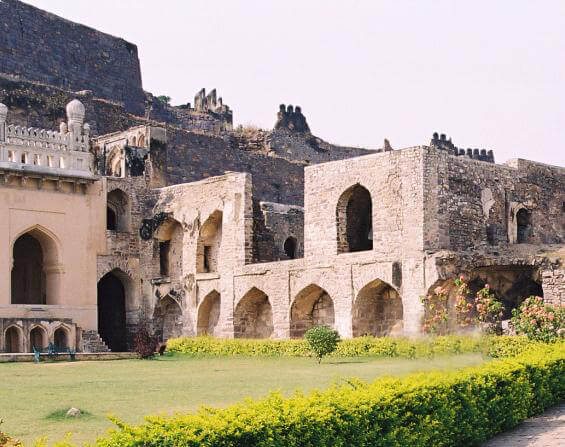
500 years have passed since the construction of this fort. Golconda is a testament to the Nawab’s rule and history, having survived many disasters and invasions over the years. There are many remarkable structures inside the fort. During the construction of the fort 87 crescent towers were built within a radius of 10 km to protect it from enemies. Cannons can still be seen in some of the towers.
Golconda Fort still stands in splendor today with 8 main lion gates, 4 towering bridges, many royal palaces, temples, and mosques. Once on the outskirts of Bhagyanagar, the Golconda is now an integral part of the city, thriving as a heritage treasure. Some of the buildings found inside the fort are Habshi Commons (Abyssian Arches), Ashlah Khana, Taramati Mosque, Ramdas Bandikhana, Camel Stable, Private Room (KW), Mortuary Bath, Nagina Bagh, Ramsasa’s Kotha, Durbar Hall, Amber Khan, etc.
Amazing acoustics
According to phonology, a structure was built here so that those above would know immediately if anyone entered the fort illegally. Standing near the structure and clapping, the sound can be heard up to a kilometer above the fort. Built to protect against enemies, the building has now become a tourist attraction. Tourists get a strange feeling while standing here and clapping.
Ramadasu Jail
Lord Tanisha imprisoned Sri Ramadasu in the fort for building the Ramalaya in Bhadrachalam. Statues of Sitaram carved by Sri Ramadasu are still visible in the prison at that time. People also pay homage to those idols. Tourists visiting Golconda cannot go without seeing the Ramadasu Dungeon.
Baradari
Baradari is a three-storied assembly hall in the Golconda Fort. Looking east from this pavilion, one can see the ruins of Charminar, the Mecca Mosque, and the Qutb Shah dynasty, the main structures in the city. Seeing any source like this makes something seem unique. On the upper floor of the mandapa is the royal throne. From this place, the 30 miles of the city look beautiful.
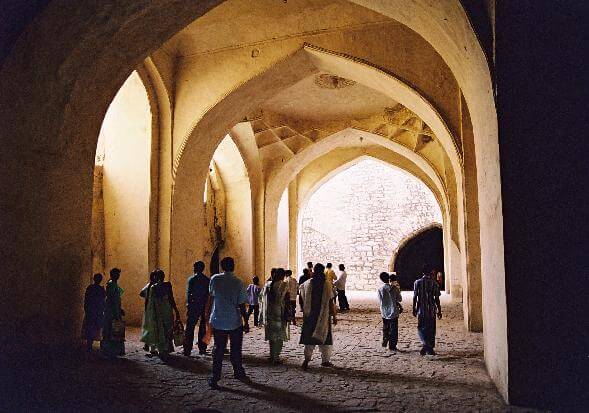
Mortuary Bath
This bathroom can be seen on the way in from the Balahisar Gate in the fort. Those who fill this room with water from the pond. Arrangements have also been made for hot water and channels to come here. The royal family used to bathe here with hot water when someone died. It is said that this bathroom is used only in the most important cases.
Yellamma Devi
The Ellamma Devi Temple was built in the Golconda Fort during the reign of Tanisha and her elder sister Madanna. Bona fairs are held here every year during the month of Ashada. Large numbers of people from the twin cities flock to view the fair.
During the Kakatiya period, a statue of a shepherd goddess was found on the Golconda hill and the Kakatiya kings built a structure out of clay there. Times have passed but the idol of the goddess is still worshiped by the people. Bonas is first offered to the sellers at the Bonala Fair.
Fateh Darwaza
One of the main attractions of Golconda Fort is the Fateh Darwaza (Victory Gate), which was named after the Mughal emperor Aurangzeb’s capture of the fort after the siege of it for eight years. Aurangzeb’s victory over the Golconda Fort led to the demolition of its magnificent structure.
The Journey of the Koh-i-Noor Diamond and Other Diamonds
The area was popular for its mines; So popular that they brought prosperity to many rulers of Hyderabad including the Nizams and Qutb Shahis. If some sources are to be believed, India was one of the places where diamonds were mined during that period. The region was famous for its mines, especially the Kollur mines, which extracted some of the most precious gems in history. Hence, during the Kakatiya dynasty, Golconda gradually became the center of diamond cutters. It was also a place where precious stones and gems were sold in the market here. The Khans brought prosperity to many rulers of Hyderabad, including the Qutb Shahis and the Nizams.
Also, speaking of coveted precious stones, it is believed that the famous Kohinoor, Dariya-i-Noor, and Hope Diamond were unearthed. The area is home to precious diamonds such as the Hope diamond, the Nasak diamond, and the Koh-i-Noor diamond, one of the most precious gems in India.
The fort also has some ancient temples built by the Kakatiya kings. Apart from Hindu temples, many mosques are also found here.
Golconda is the largest fort in the Deccan. It is said that there is no other fort in South India with such architectural splendor, area, and variety. It is impossible to rebuild such a fort built in those days when there was no technology. Golconda Fort is listed as an archaeological treasure by the Archaeological Survey of India on the official “List of Monuments” prepared under the Ancient Monuments and Archaeological Sites and Remains Act. Golconda Fort, Qutb Shahi Tombs, Charminar, and Thousand Pillar Temple in Hanamkonda have been nominated for the UNESCO World Heritage Site recognition.
Hundreds of people visit the Golconda Fort every day, which is magnificent in Italian and Persian styles. After learning about the history of Golconda, you too will not feel like visiting this place even once. There are good transport facilities from all over the country to reach Golconda. Golconda can be reached by train, road, and air in 30 minutes from Hyderabad by taxi or bus. Why not make Golconda part of your holiday trip this time too late? Take historical experiences with you.
Golconda Fort Interesting Facts
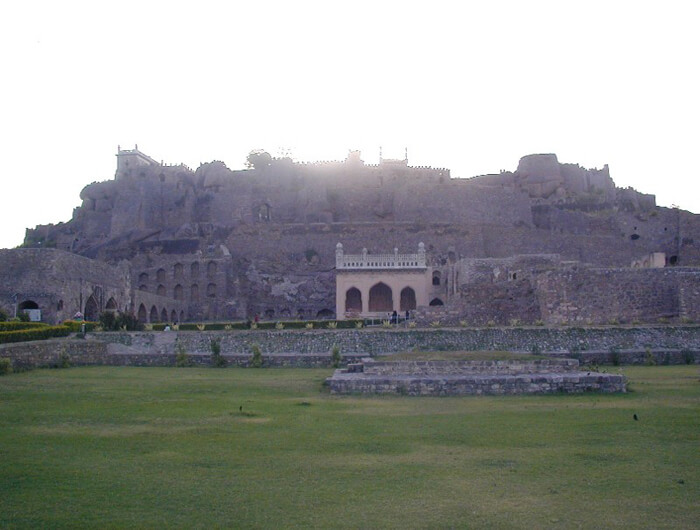
- 425 years old tree is still there –
An African Baobab tree, which was also known by the local people as the tree of Hatia, this tree comes into the new fort complex. This tree is 425 years old. It is said that Arabian traders gifted it to Sultan Muhammad Quli Qutb Shah. - It was a brick fort that was later expanded –
Golconda Fort was built by the Kakatiya rulers in the 13th century. Earlier it was only a brick fort and later it was expanded. - The world famous diamond –
Darya-i-Noor, Noor-ul-Ain diamond, Kohinoor, Asha diamond, and Regent Diamond were with the Sultan of Golconda before leaving India. - Ancient madman saved the city –
Once upon a time, there was a madman, Majjub, who lived behind the Fateh Darwaza and guarded it. When Aurangzeb was preparing to enter the fort, he could never attack while this madman was there. Only an officer of the Mughal army had asked him to leave the place so that Aurangzeb could attack the fort. - Tali Maro Miyan –
You can easily hear the clap played at the entrance of the fort in the Bala Hisar Theater of the fort, which is the topmost part of the fort. It signifies two things – either the intruder has come in, or an emergency has occurred. It was also used so that the people of the royal family could know about the upcoming guests. - Mahakali Temple is built on the topmost part of the fort –
Shri Jagadamba Mahakali Temple was built on the topmost part of the fort. King Ibrahim Quli Qutb Shah was very famous among Hindus, Hindus also called him by the name of Malkabhiram. - This has inspired many films like Shri Ram Dasu –
Ram Dass was a revenue officer who was imprisoned by Abul Hasan Tanah Shah. Because he had misused the money in building Badrachalam Shri Ram temple. It is said that Lord Ram had come in the dream of Tanah Shah and he had also compensated for the money he had drowned to rescue Ram Dasu. - Mysterious tunnel and exit –
It is said that there is a mysterious tunnel in this fort that starts from the Durbar Hall and leads out through the lowest part of the fort. This tunnel was used by the people of the royal family to go out in emergency times but this tunnel has never been seen at present. - Voice and Light Show –
The beautiful voice and light show here is the main point of attraction for the audience. Through this, the stories of the kings, love, and history are told. This scene is a must-watch!!! - This fort inspired three places with similar names in the USA, first Arizona, second Illinois, and third Nevada –
The mining town is also in Golconda, Arizona and today it is called a ghost town, the name of that place is Golconda It was placed just after the fort.
Suggested Read: Charminar – Hyderabad’s four towers
